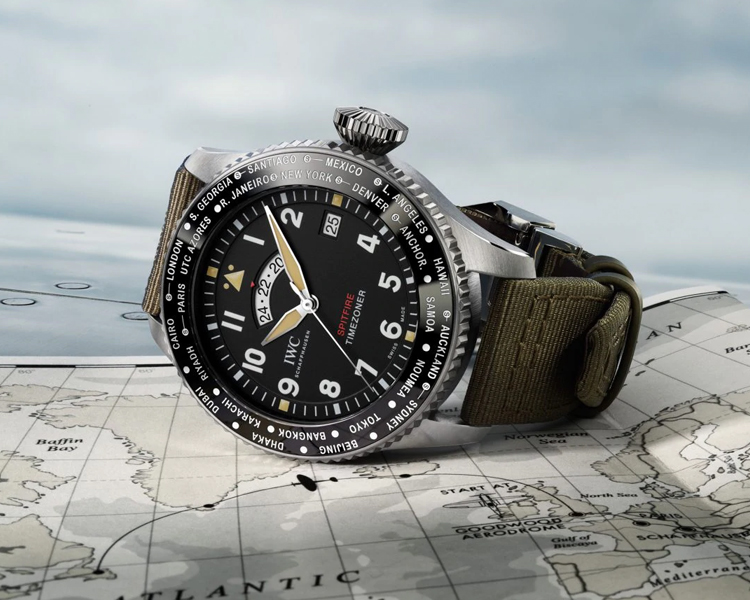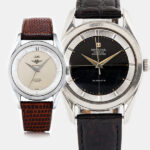IWC Schaffhausen or simply IWC produces one of the best pilot watches. With the watches’ robustness and durability, they surely developed into a crowd favourite. As one of the most sought-after timepieces, the family of watches proves iconic in the industry. But with IWC’s rich series of pilot watches, it can be quite a daunting job to figure out which to pick. So, we gathered all the best IWC pilot watches to help you. But like any brand’s iconic collection, its legacy roots from the company’s rich history. Read on to learn more about IWC and their affiliation to robust timepieces.
History of IWC Schaffhausen
The beginnings of IWC wasn’t a smooth-sailing ride. Its founder, an American engineer and watchmaker Florentine Ariosto Jones went through a lot to put up this company.
At 27, Jones served as deputy director and manager with the E. Howard Watch and Clock Co. in Boston. At the time, the brand led the American watchmaking industry. Also during that time, most people travelled to the US to try their luck. However, as a kick from his adventurous nature, Jones went the other way to Europe. To say the least, his plans didn’t quite work.
In 1868, Jones founded his own company enthusiastically named International Watch Company. Jones planned to leverage every possible source he could get his hands on. Firstly, he attempted to employ the help of remarkable Swiss watchmakers. Their expertise combined with modern technology surely gave the company the upper hand in the market. During this time, low wages challenged Switzerland despite the availability of skilled watchmakers who worked at the comfort of their homes. Jones’ plans to put up a factory in Switzerland didn’t pull through. Facing the masters of horology in the Geneva region and other remote valleys in Switzerland, Jones got a taste of true scepticism. Surely, the times declined his luck.
Beginnings in Schaffhausen, Switzerland
Before this, however, the town of Schaffhausen faced the danger of being left behind in the Industrial Age. So, watch manufacturer and industrialist Heinrich Moser put up the town’s first-ever hydroelectric plant. This became the foundation of the town’s future industrialisation. Meeting with Jones in Le Locle, the two watchmakers collaborated to become the only watch manufacturers in north-eastern Switzerland. Thus, The International Watch Company in Schaffhausen. Before this, however, the brand earned a reputation as the International Watch Chronology. To this day, the name still resounds among horologists and watch connoisseurs.
Jones rented the first factory’s property at Moser’s industrial building in 1869 at the Rheinstrasse. Quickly after this, the company needed to expand. So, Jones rented more rooms in the Oberhaus, one of Schaffhausen’s oldest buildings. As the mid-1970s approached, Jones crafted plans for a new factory. As a part of the plan, he purchased a site from Moser’s hydroelectric company. The site, directly adjacent to the banks of the Rhine, took advantage of the river’s capacity. After winning a bid, architect G. Meyer designed and led the building of the new factory. In 1875, the plant opened allowing up to 300 workplaces to function with 196 workers in the 45-metre long factory. This hydro-powered manufacture produced high-quality pocket watch movements recognised by the market.
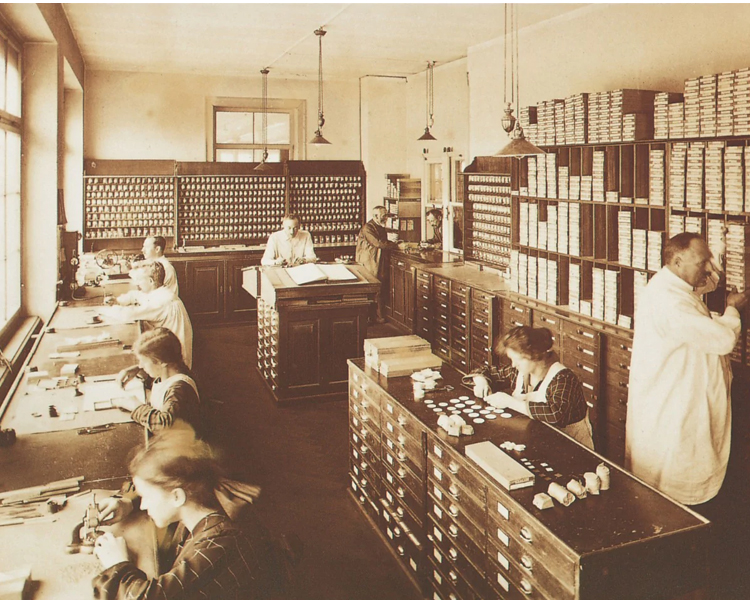
Change of Management
Jones, later decided to come home to the United States after serving years crafting watches in Schaffhausen. A family of industrialists from Schaffhausen, the Rauschenbachs, bought the company. Under their management, the company saw four generations of varying names. With the Rauschenbachs leading the company, IWC produced pocket watches with a digital “Pallweber” display. Along with these products, IWC also crafted wristwatches for men and women.
After the reign of the Rauschenbach, following the death of Johannes Rauschenbach-Schenk, Ernst Jakob Homberger took over the company. The industrialist saw the birth of two watch families that remain iconic to this day. One of those, the “Spezialuhr für Flieger” started the production of pilot watches in Schaffhausen. Through the watches’ remarkable design, they never fail to impress enthusiasts to this day.
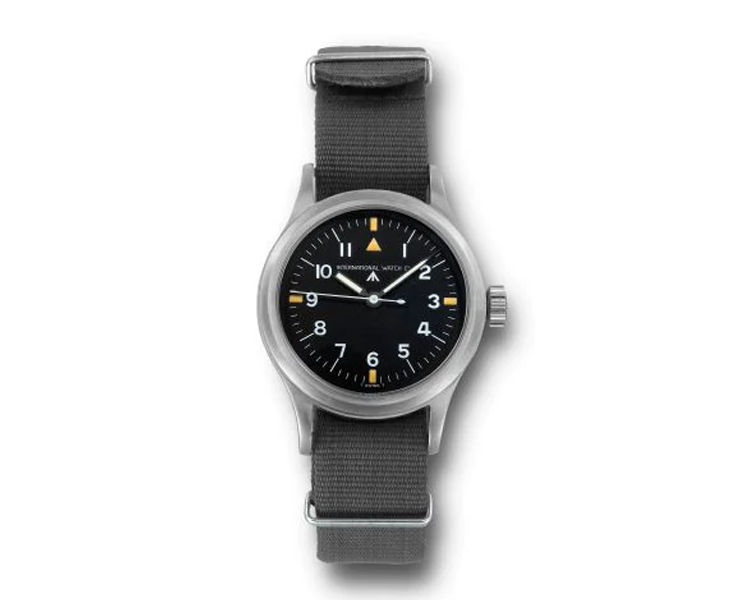
The First Pilot’s Watches by IWC
In 1939, the first IWC “Special Pilot’s Watch” was launched, much to the market’s delight. The watch, powered by the company’s Calibre 83, featured an antimagnetic escapement. It also featured a shatterproof crystal. It had hands and hour indexes of great contrasts as well as a rotating bezel. The bezel helped measure and record short periods of time. Particularly, the arrowhead index registered take-off times effectively. Moreover, the watch proved highly resistant to fluctuations on temperature from -40 degrees Celcius to +40 degrees Celsius.
As the watched established itself as a well-received success, IWC crafted a new pilot watch — the Big Pilot’s Watch (Ref. IW431) with 55mm of case diameter, 16.5mm in height, and 183 grams. This limited-edition watch demonstrated the biggest watch IWC ever manufactured. The watch accompanied the Luftwaffe or the German Air Force in 1940 in 1,000 editioned pieces. IWC followed this up 8 years later. The company took pride in creating another antimagnetic watch. IWC Mark 11 Pilot’s Wristwatch came with a NATO strap and Calibre 89. As a response to the British government’s demands, IWC supplied this watch to the Royal Air Force (RAF).
These timepieces only marked the beginning of what we know today as an iconic family of watches.
IWC Pilot’s Watches Family
It’s best to understand the differences between the series of IWC pilot watches. What exactly makes each one of them unique? Here are the collections in the Pilot’s Watches Family and the top 3 watches for each series.
Classic
IWC usually takes inspiration from the first pilot’s watches from its history to create new ones. The Classic collection of IWC Pilot’s Watches surely captures just the essence of these timepieces. These display the technical benchmarks set by the brand in the 1930s and 1940s. The dials display a look that picks up from its predecessors with caution.
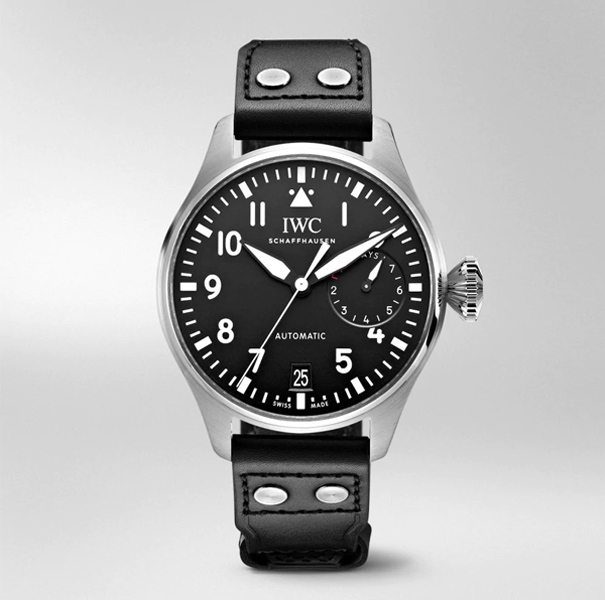
1. Big Pilot’s Watch
Launched in 2016, the IWC Big Pilot’s Watch directly descends from the iconic Ref. IW431 Big’s Pilot Watch. With a gentle facelift to meet modern standards and needs, it remains true to its nature. Featuring the IWC-manufactured 52110-calibre movement, the watch displays one of the brand’s and the industry’s greatest achievements. This watch truly comes with technology’s greatest gifts with the Pellaton automatic winding system. This includes parts made from black or white ceramic. Moreover, the two barrels boosts the watch’s power reserve for up to 7 days. At 3 o’clock, a power reserve indicator tells exactly the remaining time until the movement halts.
With a sleek date display at 6 o’clock, the watch speaks incredible balance, especially for a 46mm case. Furthermore, the watch features a water resistance of up to 60m and a soft-iron inner case that makes the watch truly antimagnetic. The big conical crown aides for better grip and usage of the watch.
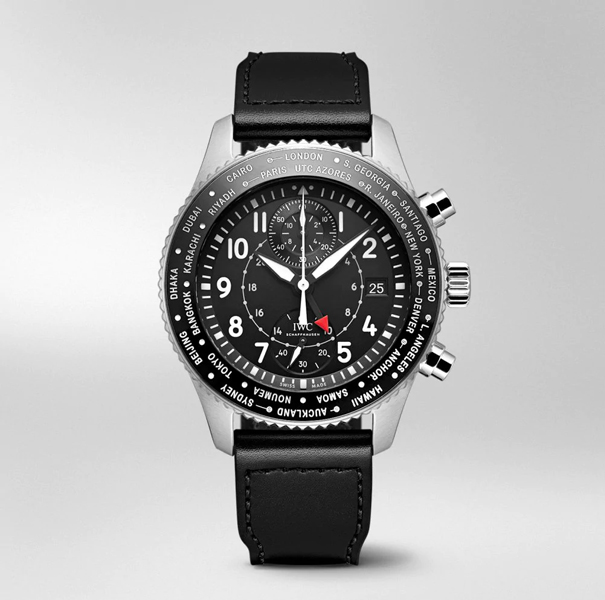
2. Pilot’s Watch Timezoner Chronograph
The IWC Pilot’s Watch Timezoner Chronograph was built from the watch’s greatest watches. This watch leverages three technologies brought together by the company’s engineers. The watch allows for a quick and easy timezone change with just a push and turns on the bezel. The hour hand, 24-hour day/night display and the date automatically to the desired timezone with the motion.
For this to be possible, firstly, the engineers take the Pilot’s Watch Worldtimer 2012 where cities mark timezones for various countries all over the world. Secondly, IWC applied the spring-mounted rotating bezel technology on the watch made to prevent accidental timezone resets. First seen in the Porsche Design Ocean 2000 from the 1980s, the bezel only moves when pressure is applied on two diametrically opposing sides. Lastly, engineers again take from a classic; this time, from the Aquatimer. The external/internal rotating bezel transmits its movement through a differential gear toward the hour wheel, 24-hour hand, and date wheel.
Further building from its predecessor, this watch features a flyback Chronograph with hours, minutes and seconds functions. The watch’s 89760 Calibre allows for 68 hours of power reserve with 39 Jewels and frequency of 28,800 beats per hour.
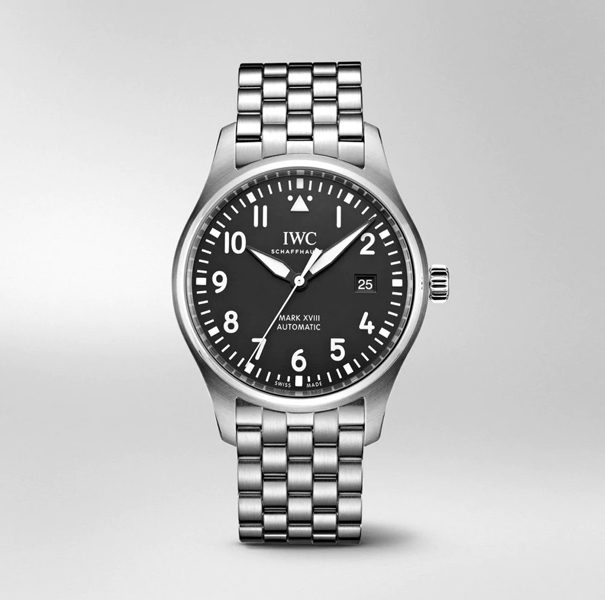
3. Pilot’s Watch Mark XVIII
The IWC Pilot’s Watch Mark XVIII takes from its historic forebearer, the legendary Mark 11. To bring justice to its forerunner, it features a soft-iron inner case for protection against magnetic fields. It also has a front glass secured against displacement by abrupt drops in atmospheric pressure. This watch, of course, builds upon the great features of the Mark 11 with modern technology. Inside its 40 mm stainless steel case, the dial functions only with the necessary information. Designed to be legible and clear, it keeps the wearer from being distracted by the unnecessary.
To up its legibility game, the watch features hands that contrast its background. It also has a luminescent coating for optimum readability even on dimly lit places. The large Arabic markers leave no room for mistakes. Furthermore, this watch boasts water resistance of up to 6 bar. The automatic IWC 35111 Calibre movement also allows for 42 hours of power reserve. Moreover, the watch comes in various designs and strap combinations.
Top Gun
The TOP GUN collection boasts itself as one of the best collections under the Pilot’s Watches family for the best reasons. Firstly, it follows the greatest in aviation. In honour of the greatest aviators in history, IWC takes pride in this line of watches.
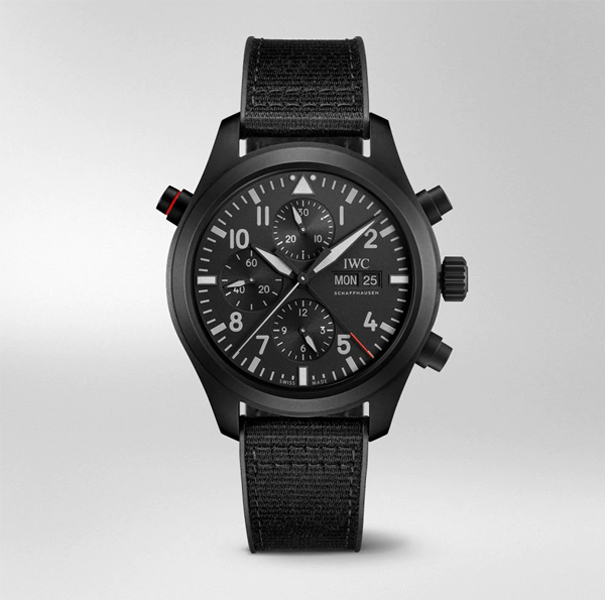
1. Pilot’s Watch Double Chronograph Top Gun Ceratanium
Developed by IWC, Ceratanium combines the greatness of ceramic and titanium in one truly robust material. Based on a titanium alloy, expect the lightness that comes with this material and the rigidity it ensures. To further its advantages, it’s as hard, wear-free, and scratch-resistant as ceramic. This patented material also boasts remarkable corrosion resistance and skin-friendliness. So you’re sure to wear this with utmost comfort. It’s also stylish and comes in a striking matte black colour. For this particular watch, IWC assures a Ceratanium-made component. That includes the pushbuttons as well as pin buckle. This guarantees a compelling jet black design code.
This Double Chronograph Top Gun Ceratanium watch features an integrated split-seconds function. This enables the wearer to time two independent or separate actions at the same time. Powered by the 79420 Calibre movement, this automatic timepiece boasts 44 hours of power reserve. If these features don’t convince you just yet, the watch also features the same soft-iron inner case for protection against magnetic fields.
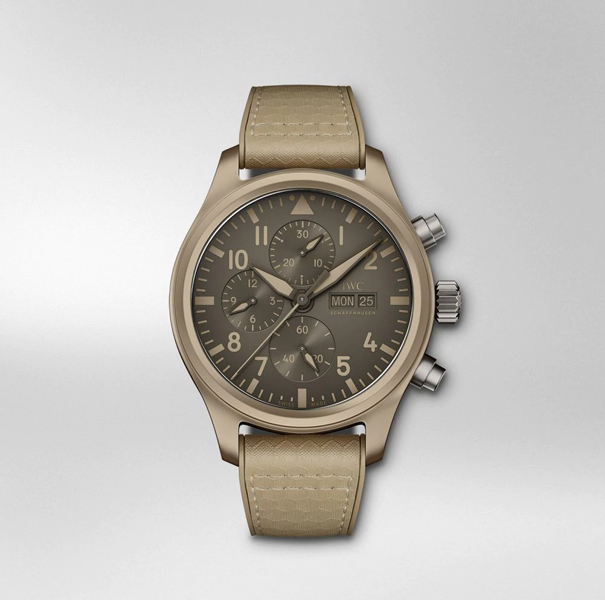
2. Pilot’s Watch Chronograph Top Gun Edition “Mojave Desert”
From a jet black ceramic watch to a sand-coloured timepiece, IWC continues to impress with the TOP GUN series. The Top Gun Mojave Desert Edition takes inspiration from the Mojave Desert, where China Lake Naval Air Weapons Station sits. This is the US Navy’s largest single landholding. The watch’s colour greatly matches that of the flying suits of Navy pilots. It also bears as a result through a combination of zirconium oxide with other metallic oxides.
This limited-edition watch features a chronograph powered by the IWC-manufactured 69380 Calibre. More than the watch’s stopwatch function, the watch also features a classic column-wheel chronograph movement for day and date displays. The movement’s bidirectional pawl-winding system allows a power reserve of up to 46 hours.
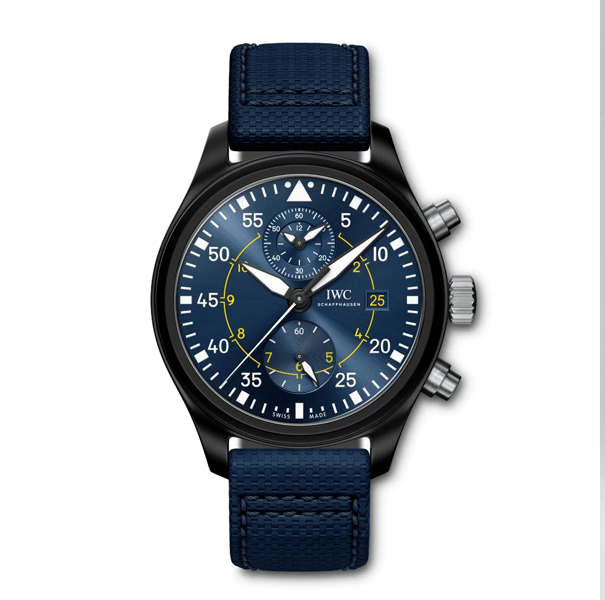
3. Pilot’s Watch Chronograph Edition “Blue Angels”
As an official Licensee of the US Navy Blue Angels Flight Demonstration Squadron, IWC crafted this chronograph. This aerobatics flying team, founded in 1946, comprises six Navy and Marine pilots, who fly F/A-18 Hornet jets. Powered by the IWC-manufactured 89361 Calibre, the watch displays stopped hours and minutes on a sub-dial at 12 o’clock. Through the integrated flyback function, a single push of a button allows the stopwatch hands to return back to zero and start anew with its measurement. With a case made of matte black zirconium oxide ceramic, the watch proves robustness and durability. Moreover, it’s stylish with blue dial and calfskin strap. On the watch’s caseback, the crest of the «Blue Angels» is engraved.
Spitfire
Spitfire, the British single-seat fighter aircraft used by RAF, inspired its own collection rightfully so. As aforementioned, IWC crafted a timepiece for the RAF in 1948, the Mark 11. Heavily inspired by this timepiece, IWC marries its aesthetic with the cutting-edge technology of the legendary fighter plane.
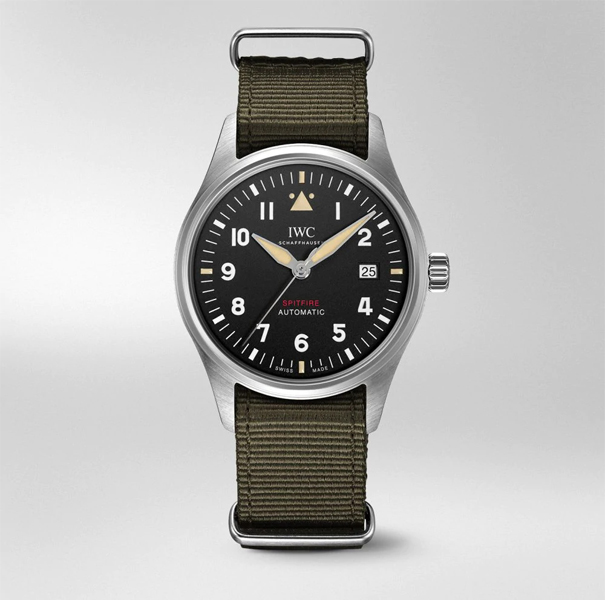
1. Pilot’s Watch Automatic Spitfire
A pure modern interpretation of the Mark 11, the IWC Pilot’s Watch Automatic Spitfire clearly resembles its forerunner. Powered by the IWC-manufactured 32110 Calibre, the watch boasts a robust automatic movement with a bidirectional pawl-winding. This allows for up to 72 hours of power reserve. Moreover, it comes with a case measuring only 39mm in diameter. The watch, heavily inspired by the Spitfire’s cockpit, also includes the iconic oft-iron inner case effectively shields the movement from magnetic fields. This watch remains straightforward with information and function.
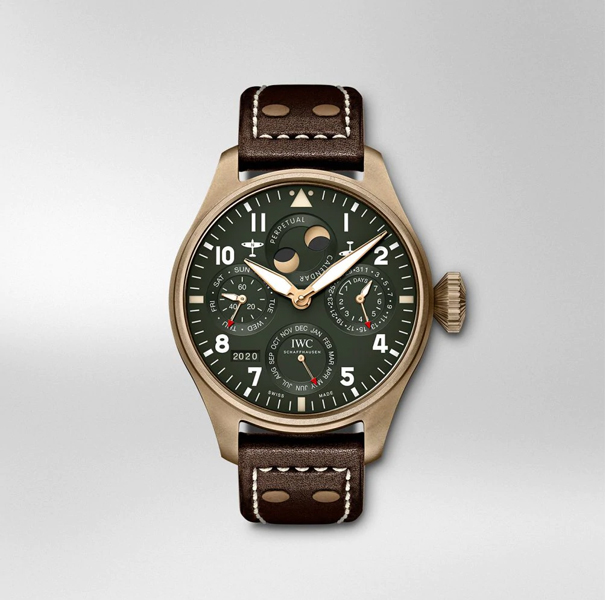
2. Big Pilot’s Watch Perpetual Calendar Spitfire
Bronze case, olive green dial, and brown calfskin strap — for a watch, this truly resembles the most popular design of a Spitfire. The bronze of the watch, with time, develops a patina and darkens. This surely makes the watch a collector’s must-have.
The watch features a Pellaton winding system and two barrels, both found in the IWC-manufactured 52615 Calibre. Seven days of power reserve assures the watch’s reliability. It’s also robust due to the watch’s non-wearing, durable winding system. Moreover, the watch’s perpetual calendar effectively functions by recognising various lengths of months as well as leap years, automatically. This requires no correction until the year 2100. It’s also easy to navigate via only the crown. The watch also features a double moonphase display.
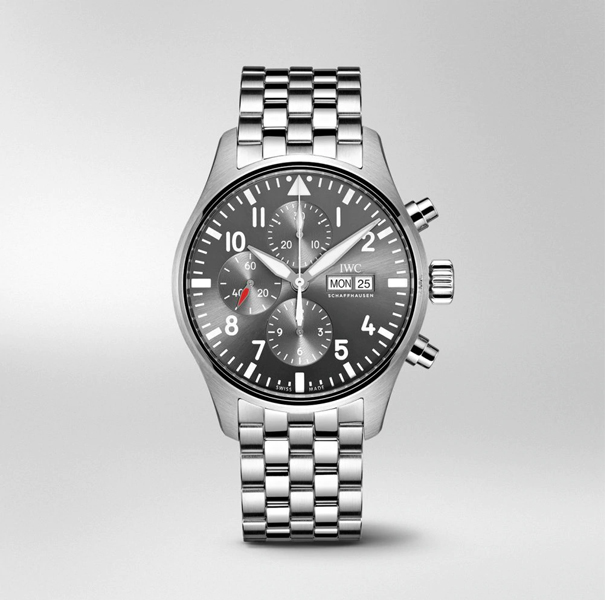
3. Pilot’s Watch Chronograph Spitfire
Style meets function with this watch, featuring its stainless steel case and an almost monochromatic colourway. At 43 mm, the Chronograph Spitfire remains balanced with integrated day and date displays on the dial. The subdial at 9 o’clock functions adds a red tinge with the seconds hand. It also indicates that the watch is running normally. Aside from this, the watch remains truly monochromatic with a slate-coloured, metallic dial. Designed as a tribute to the grey fuselage of the plane, this clever choice gives it an impression of the iconic Spitfire. With a soft-iron inner case as with other watches from the family, the watch provides anti-magnetic protection for the high-precision movement.
Le Petit Prince & Antoine de Saint-Exupéry Collections
These collections, defined apart, go very well together for obvious reasons. The iconic story truly resembles IWC’s dedication to aviation. To seal this affiliation, IWC released special-edition timepieces with trademark blue dials to commemorate the “The Little Prince”. The story, translated into over 300 languages, remains as one of the most popular, if not the most popular, literary works. As a dedication to the author, IWC launched special-edition watches with tobacco brown dials named after the author, Antoine de Saint-Exupéry.
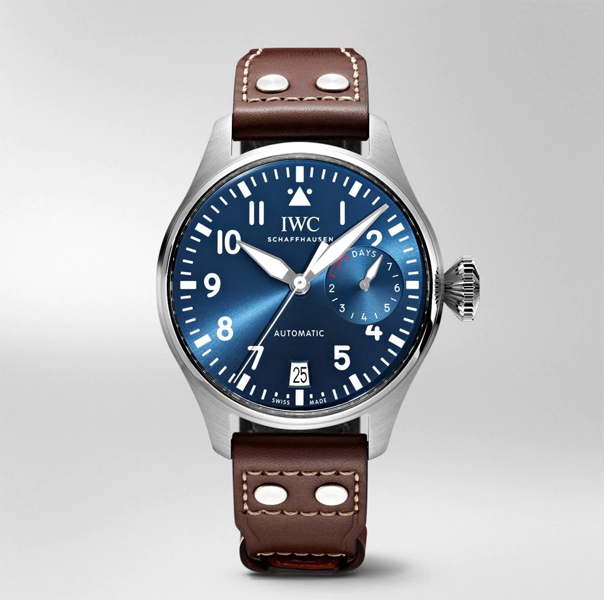
1. Big Pilot’s Watch Edition “Le Petit Prince”
Adding a touch of “The Little Prince” to the Big Pilot’s Watch, the IWC Le Petit Prince timepiece features a brown dial. As other Big Pilot’s Watches, this timepiece features 7 days of power reserve with the help of two barrels. At 3 o’clock the power reserve indicator tells just how much time left until the movement halts.
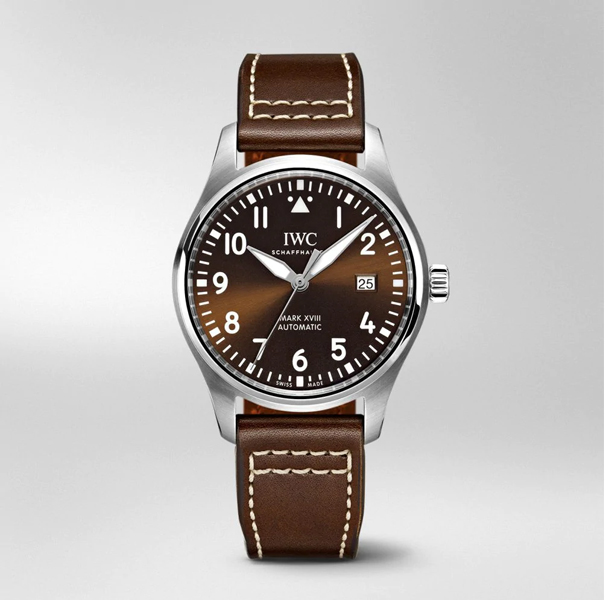
2. Pilot’s Watch Mark XVIII Edition “Antoine de Saint Exupéry”
Taking simplicity to account, the Antoine de Saint Exupéry Edition of the Mark XVIII features a brown dial and typical calfskin strap. Antoine de Saint Exupéry, also a pilot, wears a flying suit that inspired the colours of this watch. On the case back, you’ll find a Lockheed P-38 Lightning. This aircraft demonstrates the aircraft the author took off on what would be his last reconnaissance flight over the south of France on 31 July 1944. With legibility as a priority, the watch highlights form and function over other unnecessary details.
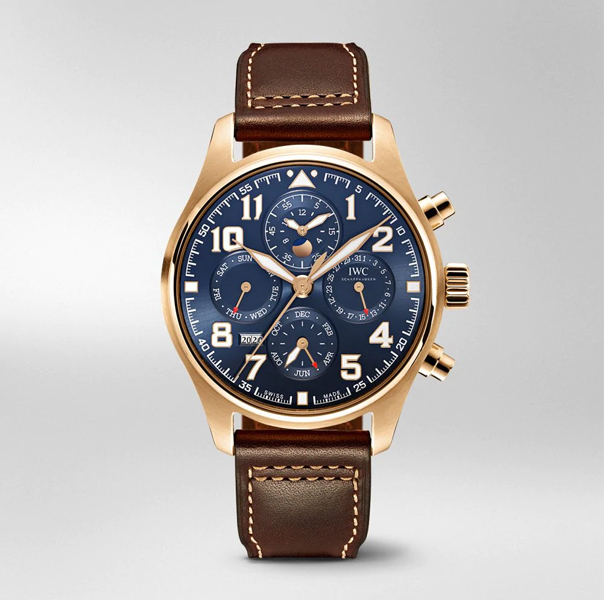
3. Pilot’s Watch Perpetual Calendar Chronograph Edition “Le Petit Prince”
As with the aforementioned perpetual calendar chronograph, this watch bears the same system designed by Kurt Klaus in the 1980s. It predicts various month and year lengths, including leap years. Therefore, the watch doesn’t need readjustment until 2100. If left unused for a while, a turn of the crown winds it back up. The blue dial speaks “The Little Prince” and gives you a sense of a calm nigh sky on a long journey.
The True Aviator’s Choice
It’s almost as if IWC equates itself with pilot watches. Unsurprisingly so, the brand boasts its great affiliation with the aviation industry and proves itself an ally. More than providing functional watches, the company has a long history of respecting inspirations. It built this family of pilot watches with knowledge and passion not only for horology but also for aviation.
Looking for more watches inspired by aeronautics? Check out these vintage airship-inspired Zeppelin Watches.
